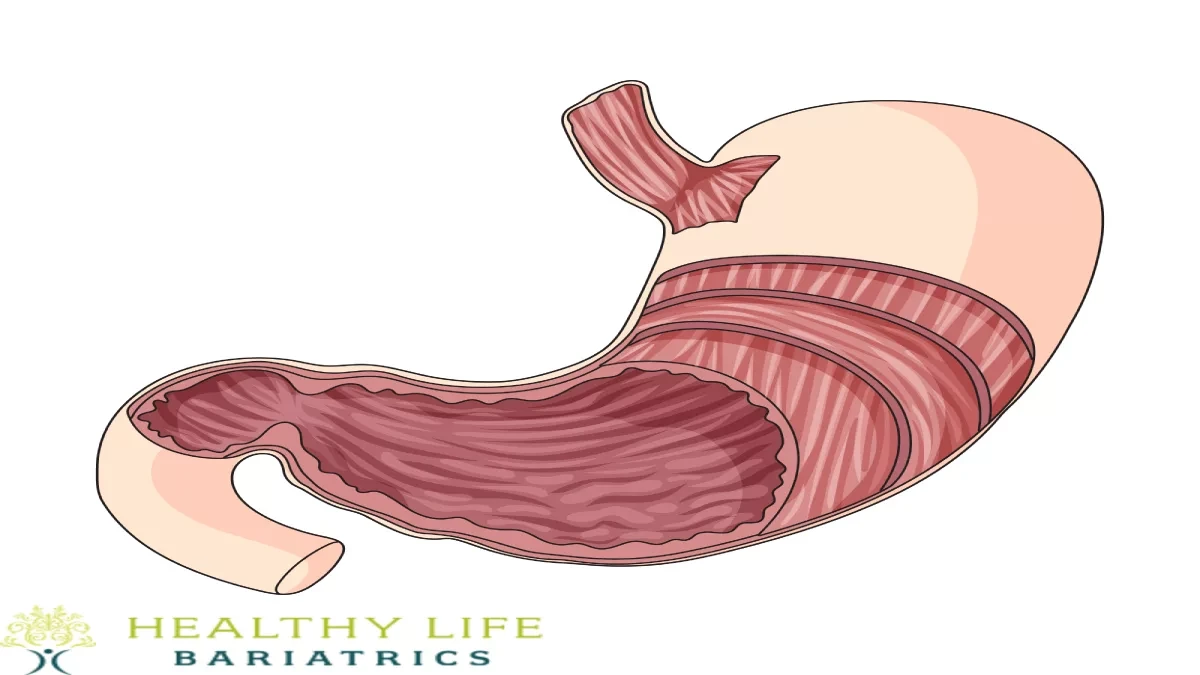The endoscopic revision of gastric sleeve procedure is a minimally invasive technique that aims to address weight regain and expanding stomach volume after a sleeve gastrectomy. This procedure is an alternative to more invasive revision surgeries, offering a safer and less complicated option for patients who have experienced weight regain or an increase in stomach size following their initial gastric sleeve surgery.
The gastric sleeve surgery, also known as sleeve gastrectomy, involves the removal of a large portion of the stomach to create a smaller, sleeve-shaped stomach. While this surgery is effective in reducing the stomach’s capacity and promoting weight loss, some patients may experience weight regain or an expansion of their stomach volume over time.
The endoscopic revision of gastric sleeve procedure offers a solution to these issues. It involves the use of an endoscope, a flexible tube with a camera and surgical instruments, to access the stomach and make modifications. One such modification is the sleeve-in-sleeve (SIS) procedure, where a new sleeve is created within the existing sleeve. This additional sleeve further reduces the stomach’s capacity, helping to restrict food intake and promote weight loss.
The benefits of the endoscopic revision of gastric sleeve procedure, particularly the sleeve-in-sleeve technique, include its minimally invasive nature, shorter recovery time, and reduced risk of complications compared to traditional revision surgeries. It allows patients to address weight regain and expanding stomach volume without undergoing an open or laparoscopic surgery, minimizing scarring and discomfort.
In conclusion, the endoscopic revision of gastric sleeve, specifically the sleeve-in-sleeve procedure, offers an effective and minimally invasive solution for patients experiencing weight regain and expanding stomach volume after a sleeve gastrectomy. This procedure provides numerous benefits and allows patients to address these issues without the need for more invasive revision surgeries.

Sleeve-in-Sleeve (SIS) is an endoscopic procedure used to treat weight regain after sleeve gastrectomy. This minimally invasive technique aims to restore the tightness of the gastric sleeve by creating plications or folds within the existing sleeve.
During the SIS procedure, an endoscope is inserted through the mouth and into the stomach. A second smaller endoscope, known as the “inner sleeve,” is then advanced through the first endoscope and positioned within the existing gastric sleeve. This inner sleeve is then sutured or stapled to the outer sleeve, creating plications that reduce the size of the stomach pouch and enhance restriction.
One of the key benefits of SIS is that it can be performed without the need for major surgery or additional incisions. This reduces the risk of complications, shortens recovery time, and improves patient comfort compared to traditional revisional procedures. Additionally, SIS can help restore weight loss by effectively tightening the gastric sleeve, thereby restoring restriction and promoting a feeling of fullness with smaller food volumes.
The weight loss outcomes of SIS can vary based on the amount of weight regained after the initial sleeve gastrectomy. For patients with minimal weight regain, SIS can lead to significant additional weight loss. However, for those with substantial weight regain, the results may be more modest. The success of SIS also depends on patient adherence to post-procedural dietary changes and lifestyle modifications.
In conclusion, the SIS procedure offers a minimally invasive approach to treat weight regain after sleeve gastrectomy. By restoring the tightness of the gastric sleeve and creating plications, SIS can help patients achieve further weight loss and improve their overall health.
SIS, or Stomach Intervention for Weight Regain after Sleeve Gastrectomy, is a procedure used to address weight regain in patients who have previously undergone sleeve gastrectomy. It is a minimally invasive endoscopic plication treatment that aims to restore the tightness of the stomach sleeve and decrease its volume.
During the SIS procedure, a specialized endoscope with a suturing device is introduced through the mouth into the stomach. The surgeon then uses the endoscope to create and place sutures in the stomach wall, thereby folding and pleating the sleeve and reducing its size. This tightening of the stomach sleeve helps to restrict the amount of food that can be consumed, leading to weight loss.
Compared to traditional surgical interventions, SIS offers several benefits. Firstly, it is a minimally invasive procedure, which means that it requires smaller incisions and results in less post-operative pain, scarring, and a shorter recovery time. Additionally, SIS avoids the need for a revisional surgery which would involve the removal and replacement of the stomach sleeve.
The purpose of SIS is to help patients who have undergone sleeve gastrectomy and are experiencing weight regain. This weight regain can occur due to the stretching of the stomach sleeve over time, which can lead to a decrease in its efficacy. By restoring the tightness of the sleeve and decreasing its volume, SIS aims to reset the restrictive capacity of the stomach, helping patients to control their food intake and achieve sustained weight loss.
The SIS (Sleeve Interventional Stomach) procedure is performed using an endoscopic system, which allows for a minimally invasive approach without the need for external incisions or leaving scars.
The first step in SIS is the insertion of the endoscopic system into the gastric sleeve. This is done by passing a flexible tube with a camera and specialized instruments through the mouth and down the esophagus into the stomach. The surgeon is able to view the entire procedure on a monitor and manipulate the instruments accordingly.
Once the endoscopic system is in place, the surgeon begins the process of folding and fusing the stomach. This is achieved by creating structured folds or pleats within the stomach tissue using suture-like devices. These folds help to reduce the size of the stomach and restrict its capacity, simulating the effects of a gastric sleeve. The surgeon carefully sutures these folds in place to ensure long-lasting results.
Placement of the plications is the final stage of the SIS procedure. Multiple plications are strategically placed along the stomach to further enhance the restrictive effects. These plications further minimize the size of the stomach and reduce its ability to stretch, leading to increased satiety and reduced food intake.
In summary, the SIS procedure is performed using an endoscopic system that is inserted into the gastric sleeve. The surgeon folds and fuses the stomach using specialized instruments and creates plications for added restriction. This minimally invasive procedure is an effective alternative to traditional surgical approaches, offering patients a scar-free option for weight loss.

SIS, or Sleeve Internal Suture, is a surgical technique that aims to prevent weight regain in patients who have undergone sleeve gastrectomy, a procedure where a portion of the stomach is removed to create a smaller stomach pouch. The success of SIS in ensuring long-term weight loss outcomes depends on several factors.
Weight regain is a common concern after sleeve gastrectomy, with studies reporting an average weight regain of 20- 30% within 5 years. However, SIS has shown promising results in preventing weight regain. By reinforcing the staple line and restoring the structure of the sleeve, SIS reduces the risk of dilation and stretching of the stomach pouch over time. This helps in maintaining the smaller stomach capacity, which is crucial for weight loss.
The efficacy of SIS in restoring the structure of the sleeve is an essential factor in determining weight loss outcomes. It ensures that the stomach maintains its restrictive function post-surgery, leading to effective control of food intake and satiety. By reducing the risk of pouch dilatation, SIS helps achieve sustained weight loss by preventing the stomach from stretching and accommodating larger food volumes.
Overall, the combination of sleeve gastrectomy and SIS provides promising weight loss outcomes. Patients can expect to lose a significant amount of weight after the procedure, as SIS plays a vital role in preventing weight regain and maintaining the structural integrity of the sleeve. However, individual results may vary depending on factors such as adherence to dietary and lifestyle changes. It is essential for patients to work closely with their healthcare team to optimize their weight loss journey while incorporating SIS as part of their treatment plan.
After undergoing a SIS (subintestinal stem cell implantation) procedure, the recovery process is a crucial aspect of ensuring a successful outcome. In order to ensure proper healing and minimize any potential complications, an overnight hospital stay is typically required. This enables healthcare professionals to closely monitor the patient’s condition and respond promptly to any issues that may arise.
Additionally, it is advisable to take some time off from work following the procedure. This allows the body to focus on healing and recuperation, without the added stress and demands of regular work activities.
When it comes to nutrition, a gradual progression of diet is usually recommended. Initially, a liquid meal plan is typically prescribed to aid in digestion and minimize strain on the gastrointestinal system. This may include clear broths, protein shakes, and other easily digestible liquids.
As the recovery progresses and the body adjusts, a transition to a soft food plan is typically advised. This may involve foods that are gentle on the digestive system, such as mashed potatoes, pureed soups, and soft fruits.
One noteworthy aspect of the recovery process after SIS is the absence of lifting restrictions. Unlike other surgeries, SIS usually does not require limitations on heavy lifting post-procedure. However, it is always important to listen to the advice of your healthcare provider and avoid any activities that may cause strain or discomfort to the abdominal area.
In conclusion, the recovery process after SIS involves an overnight hospital stay, time off from work, and a gradual progression from a liquid to a soft food diet. By following these guidelines and taking necessary precautions, patients can support their body’s healing process and promote a successful outcome.
To be considered a candidate for Sleeve-to-Sleeve Intestinal Lengthening (SIS), an individual must have undergone a previous sleeve gastrectomy and have an enlarged sleeve. SIS is a specialized surgical procedure that aims to enhance weight loss in patients who have not achieved the desired results with their initial sleeve gastrectomy.
Unlike other bariatric procedures, SIS does not have strict Body Mass Index (BMI) criteria. Instead, the eligibility for SIS is primarily based on the patient’s prior sleeve gastrectomy and the resulting structure of their stomach. The procedure is designed for individuals who have experienced weight regain or inadequate weight loss following a sleeve gastrectomy, in which their gastric sleeve has dilated or stretched over time.
The main objective of SIS is to reduce the size of the enlarged stomach pouch to restrict food intake and promote weight loss. By reinforcing the sleeve gastrectomy, SIS allows the patient to regain the initial restrictive effect of their surgery, thereby improving the chances of sustainable and significant weight reduction.
In summary, to be considered an appropriate candidate for SIS, individuals should meet the criteria of having previously undergone a sleeve gastrectomy with an enlarged sleeve. As SIS does not have strict BMI requirements, it offers a viable option for patients who have struggled to achieve their weight loss goals through other traditional bariatric procedures.

Before undergoing the SIS procedure, there are several steps you can take to improve your health and adequately prepare yourself. Firstly, it is essential to focus on overall well-being by maintaining a healthy lifestyle. This includes engaging in regular exercise, consuming a nutritious diet, and getting enough restorative sleep.
To optimize your health before the SIS procedure, it is crucial to meet with your doctor. This consultation allows you to address any concerns or doubts you may have. Furthermore, your doctor can provide you with psychological support, ensuring you are mentally prepared for the procedure. They can also offer guidance on dietary adjustments that may be necessary pre and post-procedure, ensuring optimal recovery.
Meeting with your doctor is vital in understanding the nuances of the SIS procedure and what to expect. They can provide you with valuable information on the procedure itself and any potential risks or complications. Additionally, they will be able to address any specific concerns or questions you may have related to your health or the procedure.
In conclusion, taking steps to improve your health is crucial before the SIS procedure. Meeting with your doctor allows you to address concerns, receive psychological support, and obtain dietary guidance. Ensuring you are mentally and physically prepared before the surgery is essential for a successful outcome and a smooth recovery.
The cost of endoscopic gastric sleeve can vary depending on several factors, including the location of the procedure and the specific clinic performing it. These factors can influence the overall price of the surgery and should be taken into consideration when budgeting for the procedure.
One of the main expenses associated with an endoscopic gastric sleeve is the surgeon’s fee. The surgeon’s fee can vary based on the expertise and experience of the surgeon, as well as the location of the clinic. Additionally, the anesthesiologist’s fee will also contribute to the total cost of the procedure. Anesthesia is necessary during the surgery to ensure the patient’s comfort and safety.
Facility fees can also be a significant expense when it comes to an endoscopic gastric sleeve. These fees cover the cost of using the surgical facility and maintaining the necessary equipment and resources.
When considering the overall cost, it’s important to note that the average price range for endoscopic gastric sleeve can vary from $10,000 to $20,000. However, it’s essential to remember that this cost range is just an average and individual clinics may charge more or less.
In conclusion, the cost of endoscopic gastric sleeve can be influenced by various factors such as the location of the procedure and the specific clinic performing it. Surgeon’s fees, anesthesiologist fees, and facility fees are potential expenses associated with this procedure. The average cost range for an endoscopic gastric sleeve is between $10,000 and $20,000.
In conclusion, endoscopic revision of gastric sleeve, also known as sleeve-in-sleeve or endoscopic gastric revision, is a procedure that offers several benefits for individuals who have previously undergone gastric sleeve surgery. This procedure involves using an endoscope to modify the size and shape of the existing gastric sleeve, without the need for further invasive surgery.
The benefits of endoscopic revision of gastric sleeve are numerous. First, it provides a less invasive option compared to traditional surgical revision, which can result in shorter recovery times and reduced risk of complications. Additionally, this procedure allows for a customized adjustment of the gastric sleeve to meet the specific needs of each patient, as it can be tailored to the desired size and shape to optimize weight loss and improve overall health outcomes.
Endoscopic revision of gastric sleeve offers a minimally invasive alternative for individuals who are experiencing weight regain or inadequate weight loss following initial gastric sleeve surgery. By utilizing an endoscope, the procedure can be performed on an outpatient basis, allowing patients to return to their normal activities quicker than with traditional surgical revisions.
Overall, endoscopic revision of gastric sleeve, also referred to as sleeve-in-sleeve or endoscopic gastric revision, is a promising procedure that provides a less invasive option with several potential benefits for those who have undergone gastric sleeve surgery.